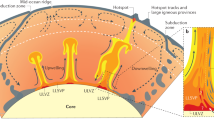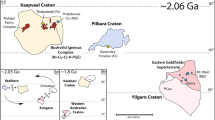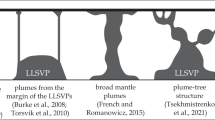Abstract
Although the majority of volcanic and tectonic activity on Mars occurred during the first 1.5 billion years of its geologic history, recent volcanism, tectonism and active seismicity in Elysium Planitia reveal ongoing activity. However, this recent pulse in volcanism and tectonics is unexpected on a cooling Mars. Here we present observational evidence and geophysical models demonstrating that Elysium Planitia is underlain by an ~4,000-km-diameter active mantle plume head. Plume activity provides an explanation for the regional gravity and topography highs, recent volcanism, transition from compressional to extensional tectonics and ongoing seismicity. The inferred plume head characteristics are comparable to terrestrial plumes that are linked to the formation of large igneous provinces. Our results demonstrate that the interior of Mars is geodynamically active today, and imply that volcanism has been driven by mantle plumes from the formation of the Hesperian volcanic provinces and Tharsis in the past to Elysium Planitia today.
This is a preview of subscription content, access via your institution
Access options
Access Nature and 54 other Nature Portfolio journals
Get Nature+, our best-value online-access subscription
$29.99 / 30 days
cancel any time
Subscribe to this journal
Receive 12 digital issues and online access to articles
$119.00 per year
only $9.92 per issue
Buy this article
- Purchase on Springer Link
- Instant access to full article PDF
Prices may be subject to local taxes which are calculated during checkout





Similar content being viewed by others
Data availability
The gravity field model from ref. 52 can be found at https://pds-geosciences.wustl.edu/mro/mro-m-rss-5-sdp-v1/mrors_1xxx/data/shadr/ and the topography model from ref. 60 can be obtained at https://doi.org/10.5281/zenodo.3870922. The colour maps used are from ref. 61 and can be found at https://doi.org/10.5281/zenodo.5501399. Additional data to reproduce Figs. 2 and 5 can be found at https://doi.org/10.5281/zenodo.7191516.
Code availability
The thin-shell flexural model from ref. 27 can be found at https://doi.org/10.5281/zenodo.7196507.
References
Carr, M. H. & Head, J. W. Geologic history of Mars. Earth Planet. Sci. Lett. 294, 185–203 (2010).
Redmond, H. L. & King, S. D. A numerical study of a mantle plume beneath the Tharsis Rise: reconciling dynamic uplift and lithospheric support models. J. Geophys. Res. Planets 109, E09008 (2004).
Tanaka, K. L. et al. Geologic Map of Mars: U.S. Geological Survey Scientific Investigations Map 3292, Scale 1:20,000,000. US Geol. Surv. Geol. Investig. (2014); https://doi.org/10.3133/sim3292
Schumacher, S. & Breuer, D. An alternative mechanism for recent volcanism on Mars. Geophys. Res. Lett. 34, L14202 (2007).
Platz, T. & Michael, G. Eruption history of the Elysium volcanic province, Mars. Earth Planet. Sci. Lett. 312, 140–151 (2011).
Nahm, A. L. & Schultz, R. A. Magnitude of global contraction on Mars from analysis of surface faults: implications for Martian thermal history. Icarus 211, 389–400 (2011).
Andrews-Hanna, J. C., Zuber, M. T. & Hauck, S. A. II Strike-slip faults on Mars: observations and implications for global tectonics and geodynamics. J. Geophys. Res. Planets 113, E08002 (2008).
Horvath, D. G., Moitra, P., Hamilton, C. W., Craddock, R. A. & Andrews-Hanna, J. C. Evidence for geologically recent explosive volcanism in Elysium Planitia, Mars. Icarus 365, 114499 (2021).
Giardini, D. et al. The seismicity of Mars. Nat. Geosci. 13, 205–212 (2020).
Voigt, J. R. C. & Hamilton, C. W. Investigating the volcanic versus aqueous origin of the surficial deposits in eastern Elysium Planitia, Mars. Icarus 309, 389–410 (2018).
Moitra, P., Horvath, D. G. & Andrews-Hanna, J. C. Investigating the roles of magmatic volatiles, ground ice and impact-triggering on a very recent and highly explosive volcanic eruption on Mars. Earth Planet. Sci. Lett. 567, 116986 (2021).
Kedar, S. et al. Analyzing low frequency seismic events at Cerberus Fossae as long period volcanic quakes. J. Geophys. Res. Planets 126, e2020JE006518 (2021).
Brinkman, N. et al. First focal mechanisms of marsquakes. J. Geophys. Res. Planets 126, e2020JE006546 (2021).
Sun, W. & Tkalčić, H. Repetitive marsquakes in Martian upper mantle. Nat. Commun. 13, 1695 (2022).
Manjón-Cabeza Córdoba, A. & Ballmer, M. D. The role of edge-driven convection in the generation of volcanism—part 1: a 2D systematic study. Solid Earth 12, 613–632 (2021).
Kiefer, W. S. & Li, Q. Water undersaturated mantle plume volcanism on present-day Mars. Meteorit. Planet. Sci. 51, 1993–2010 (2016).
Schools, J. W. & Montési, L. G. J. The generation of barriers to melt ascent in the Martian lithosphere. J. Geophys. Res. Planets 123, 47–66 (2018).
Vaucher, J. et al. The volcanic history of central Elysium Planitia: implications for Martian magmatism. Icarus 204, 418–442 (2009).
Wieczorek, M. A. et al. InSight constraints on the global character of the Martian crust. J. Geophys. Res. Planets 127, e2022JE007298 (2022).
Robbins, S. J., Achille, G. D. & Hynek, B. M. The volcanic history of Mars: high-resolution crater-based studies of the calderas of 20 volcanoes. Icarus 211, 1179–1203 (2011).
Saunders, A. D. et al. Regional uplift associated with continental large igneous provinces: the roles of mantle plumes and the lithosphere. Chem. Geol. 241, 282–318 (2007).
Smrekar, S. E. Evidence for active hotspots on Venus from analysis of Magellan gravity data. Icarus 112, 2–26 (1994).
White, R. S. & McKenzie, D. Mantle plumes and flood basalts. J. Geophys. Res. Solid Earth 100, 17543–17585 (1995).
Broquet, A. & Wieczorek, M. A. The gravitational signature of Martian volcanoes. J. Geophys. Res. Planets 124, 2054–2086 (2019).
Banerdt, W. B. Support of long-wavelength loads on Venus and implications for internal structure. J. Geophys. Res. Solid Earth 91, 403–419 (1986).
Andrews-Hanna, J. C., Zuber, M. T. & Banerdt, W. B. The Borealis basin and the origin of the Martian crustal dichotomy. Nature 453, 1212–1215 (2008).
Broquet, A. Displacement_strain_planet: 0.4. Zenodo https://doi.org/10.5281/zenodo.7196507 (2022).
Griffiths, R. W. & Campbell, I. H. Interaction of mantle plume heads with the Earth’s surface and onset of small-scale convection. J. Geophys. Res. Solid Earth 96, 18295–18310 (1991).
Kim D. et al. Improving constraints on planetary interiors with PPs receiver functions. J. Geophys. Res. Planets 126, e2021JE006983 https://doi.org/10.1029/2021JE006983 (2021)
Phillips, R. J., Sleep, N. H. & Banerdt, W. B. Permanent uplift in magmatic systems with application to the Tharsis region of Mars. J. Geophys. Res. Solid Earth 95, 5089–5100 (1990).
Knapmeyer, M. et al. Working models for spatial distribution and level of Mars’ seismicity. J. Geophys. Res. Planets 111, E11006 (2006).
Perrin, C. et al. Geometry and segmentation of Cerberus Fossae, Mars: implications for marsquake properties. J. Geophys. Res. Planets 127, e2021JE007118 (2022).
Hanna, J. C. & Phillips, R. J. Tectonic pressurization of aquifers in the formation of Mangala and Athabasca Valles, Mars. J. Geophys. Res. Planets 111, E03003 (2006).
Bryan, S. E. & Ernst, R. E. Revised definition of large igneous provinces (LIPs). Earth Sci. Rev. 86, 175–202 (2008).
Boynton, W. V. et al. Concentration of H, Si, Cl, K, Fe, and Th in the low- and mid-latitude regions of Mars. J. Geophys. Res. Planets 112, E12S99 (2007).
Baratoux, D., Toplis, M. J., Monnereau, M. & Gasnault, O. Thermal history of Mars inferred from orbital geochemistry of volcanic provinces. Nature 472, 338–341 (2011).
Hamilton, C. W., Fagents, S. A. & Wilson, L. Explosive lava–water interactions in Elysium Planitia, Mars: geologic and thermodynamic constraints on the formation of the Tartarus Colles cone groups. J. Geophys. Res. Planets 115, E09006 (2010).
Fuller, E. R. & Head, J. W. Amazonis Planitia: the role of geologically recent volcanism and sedimentation in the formation of the smoothest plains on Mars. J. Geophys. Res. Planets 107, 5081 (2002).
Campbell, B. et al. SHARAD radar sounding of the Vastitas Borealis Formation in Amazonis Planitia. J. Geophys. Res. Planets 113, E12010 (2008).
Broquet, A. & Andrews-Hanna, J. C. Plume-induced flood basalts on Hesperian Mars: an investigation of Hesperia Planum. Icarus https://doi.org/10.1016/j.icarus.2022.115338 (2022).
Morschhauser, A., Grott, M. & Breuer, D. Crustal recycling, mantle dehydration, and the thermal evolution of Mars. Icarus 212, 541–558 (2011).
Samuel, H., Lognonné, P., Panning, M. & Lainey, V. The rheology and thermal history of Mars revealed by the orbital evolution of Phobos. Nature 569, 523–527 (2019).
Plesa, A.-C. et al. The thermal state and interior structure of Mars. Geophys. Res. Lett. 45, 12198–12209 (2018).
Khan, A. et al. Upper mantle structure of Mars from InSight seismic data. Science 373, 434–438 (2021).
Broquet, A., Wieczorek, M. A. & Fa, W. Flexure of the lithosphere beneath the north polar cap of Mars: implications for ice composition and heat flow. Geophys. Res. Lett. 47, e2019GL086746 (2020).
Broquet, A., Wieczorek, M. A. & Fa, W. The composition of the south polar cap of Mars derived from orbital data. J. Geophys. Res. Planets 126, e2020JE006730 (2021).
Grott, M. & Breuer, D. On the spatial variability of the Martian elastic lithosphere thickness: evidence for mantle plumes. J. Geophys. Res. Planets 115, E03005 (2010).
Kiefer, W. S. & Li, Q. Mantle convection controls the observed lateral variations in lithospheric thickness on present-day Mars. Geophys. Res. Lett. 36, L18203 (2009).
Robbins, S. J. & Hynek, B. M. A new global database of Mars impact craters ≥1 km: 1. Database creation, properties, and parameters. J. Geophys. Res. Planets 117, E05004 (2012).
Ivanov, B. A. Mars/Moon cratering rate ratio estimates. Space Sci. Rev. 96, 87–104 (2001).
Beuthe, M. Thin elastic shells with variable thickness for lithospheric flexure of one-plate planets. Geophys. J. Int. 172, 817–841 (2008).
Genova, A. et al. Seasonal and static gravity field of Mars from MGS, Mars Odyssey and MRO radio science. Icarus 272, 228–245 (2016).
Mueller, S. & Phillips, R. J. On the reliability of lithospheric constraints derived from models of outer-rise flexure. Geophys. J. Int. 123, 887–902 (1995).
Zuber, M. T. et al. Topography of the northern hemisphere of Mercury from MESSENGER laser altimetry. Science 336, 217–220 (2012).
Crouch, S. L. & Starfield, A. M. Boundary Element Methods in Solid Mechanics (George Allen & Unwin, 1983).
Goossens, S. et al. High-resolution gravity field models from GRAIL data and implications for models of the density structure of the Moon’s crust. J. Geophys. Res. Planets 125, e2019JE006086 https://doi.org/10.1029/2019JE006086 (2020)
Wilson, L., Mouginis-Mark, P. J., Tyson, S., Mackown, J. & Garbeil, H. Fissure eruptions in Tharsis, Mars: implications for eruption conditions and magma sources. J. Volcanol. Geotherm. Res. 185, 28–46 (2009).
Wilson, L. & Head, J. W. Tharsis-radial graben systems as the surface manifestation of plume-related dike intrusion complexes: models and implications. J. Geophys. Res. Planets 107, 5057 (2002).
Schultz, R. A., Okubo, C. H., Goudy, C. L. & Wilkins, S. J. Igneous dikes on Mars revealed by Mars Orbiter Laser Altimeter topography. Geology 32, 889–892 (2004).
Smith, D. E. et al. Mars Orbiter Laser Altimeter: experiment summary after the first year of global mapping of Mars. J. Geophys. Res. Planets 106, 23689–23722 (2001).
Crameri, F. Scientific colour maps: perceptually uniform and colour-vision deficiency friendly. Zenodo https://doi.org/10.5281/zenodo.1243862 (2018).
Wieczorek, M. A., Beuthe, M., Rivoldini, A. & Van Hoolst, T. Hydrostatic interfaces in bodies with nonhydrostatic lithospheres. J. Geophys. Res. Planets 124, 1410–1432 (2019).
Edwards, C. S. et al. Mosaicking of global planetary image datasets: 1. Techniques and data processing for Thermal Emission Imaging System (THEMIS) multi-spectral data. J. Geophys. Res. 116, E10008 (2011).
Acknowledgements
This work is supported by grant 80NSSC17K0059 from the NASA Solar System Workings programme to J.C.A.-H. We thank S. Smrekar for comments that helped improve the manuscript.
Author information
Authors and Affiliations
Contributions
A.B. and J.C.A.-H. conceptualized the work and methodology, wrote the manuscript and carried out the data analyses and modelling.
Corresponding author
Ethics declarations
Competing interests
The authors declare no competing interests.
Peer review
Peer review information
Nature Astronomy thanks Suzanne Smrekar and the other, anonymous, reviewer(s) for their contribution to the peer review of this work.
Additional information
Publisher’s note Springer Nature remains neutral with regard to jurisdictional claims in published maps and institutional affiliations.
Extended data
Supplementary information
Supplementary Information
Supplementary Texts 1–5, Table 1 and Figs. 1–11.
Rights and permissions
Springer Nature or its licensor (e.g. a society or other partner) holds exclusive rights to this article under a publishing agreement with the author(s) or other rightsholder(s); author self-archiving of the accepted manuscript version of this article is solely governed by the terms of such publishing agreement and applicable law.
About this article
Cite this article
Broquet, A., Andrews-Hanna, J.C. Geophysical evidence for an active mantle plume underneath Elysium Planitia on Mars. Nat Astron 7, 160–169 (2023). https://doi.org/10.1038/s41550-022-01836-3
Received:
Accepted:
Published:
Issue Date:
DOI: https://doi.org/10.1038/s41550-022-01836-3
This article is cited by
-
Marsquakes coming into focus
Nature Astronomy (2022)
-
Constraints on the martian crust away from the InSight landing site
Nature Communications (2022)



